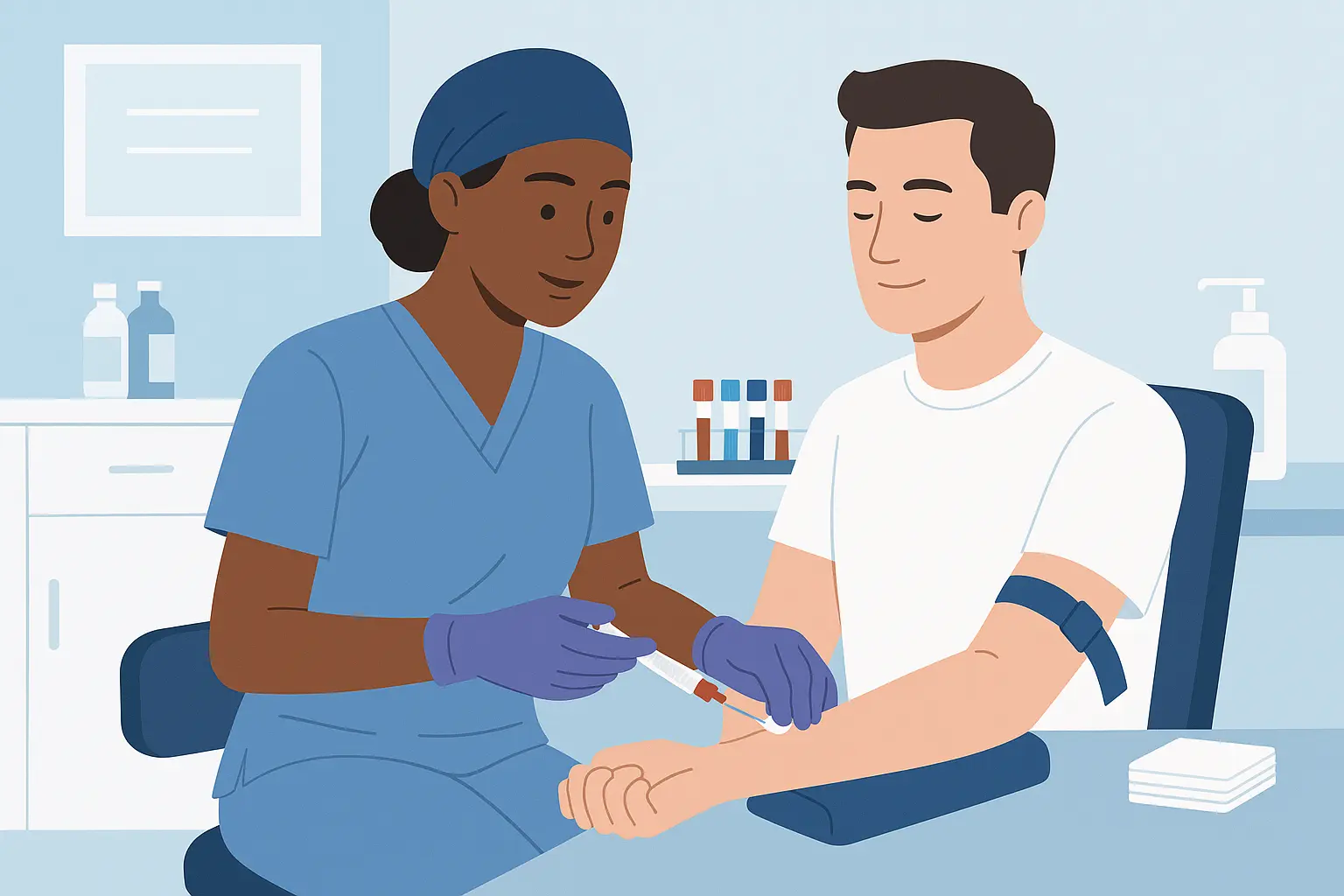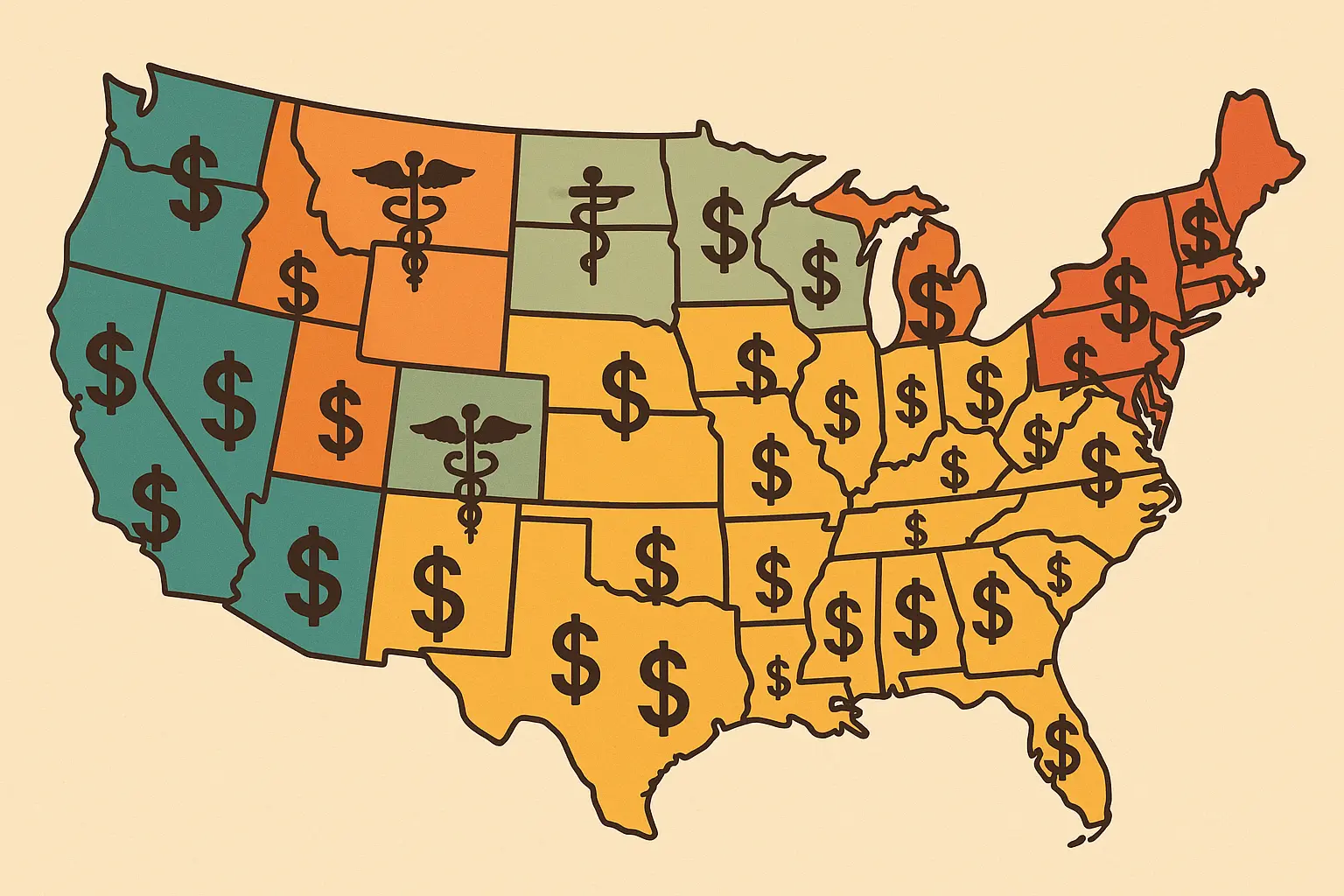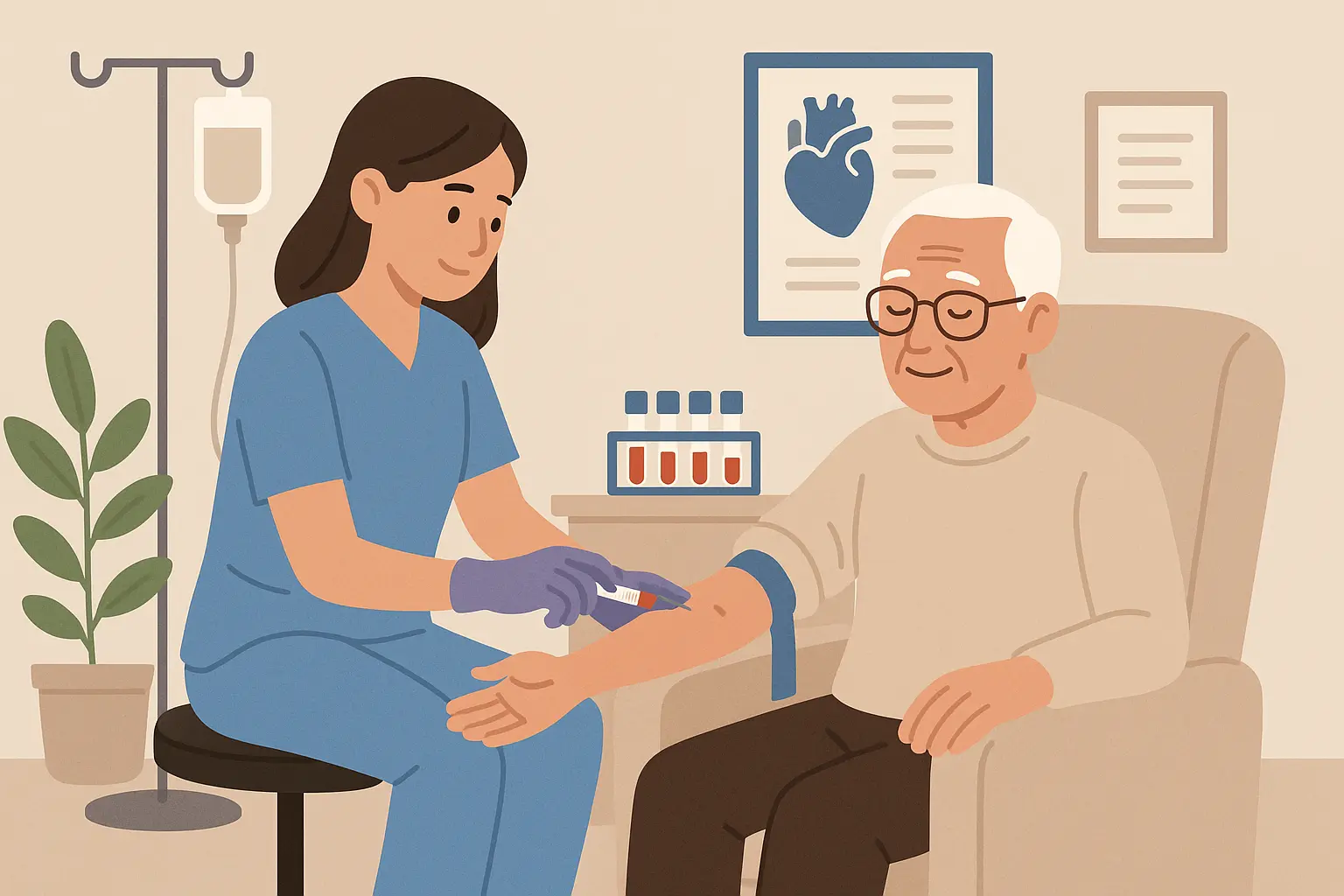What You Can Really Expect to Earn as a Phlebotomist: A Realistic Look at Salaries and Career Growth

If you’re considering phlebotomy or already working in the field, you’ve probably wondered about the earning potential. The truth is, there’s a big difference between what entry-level positions pay and what experienced professionals can make when it comes to phlebotomist salary.
The US Bureau of Labor Statistics shows the average salary is $43,660 per year or $20.99 per hour, but your actual earnings depend heavily on where you work, your experience level, and how strategically you approach your career development.
I’ve seen talented professionals settle for mediocre pay simply because they didn’t understand how to position themselves in the market. With the right approach, you can turn what many consider a “starter job” into a legitimate career that actually pays well.
Table of Contents
- Current Market Reality: What You Can Actually Expect to Earn
- Location Makes a Huge Difference in Your Paycheck
- Climbing the Career Ladder Strategically
- Don’t Ignore the Benefits Package
- Alternative Ways to Increase Your Income
- Preparing for the Future of Phlebotomy
- Final Thoughts
TL;DR – The Key Facts About Phlebotomy Pay
- Entry-level positions start around $28,000-$35,000, but strategic moves can push you past $55,000
- Location matters enormously – coastal states pay 20-40% more, but cost-adjusted earnings tell a different story
- Certifications boost your salary by 15-30% almost immediately
- Hospital work typically beats clinic work by 10-15%, but specialized labs pay the real premium
- Mobile phlebotomy can net $25-40 per draw if you’re willing to hustle
- Travel assignments often pay 20-50% above staff rates
- The field is growing 10% through 2031 – faster than most jobs
Current Market Reality: What You Can Actually Expect to Earn
Let’s talk real numbers. The national average gets thrown around a lot, but it doesn’t tell you much about what you’ll actually make starting out or what’s possible as you gain experience.
When researching phlebotomist salary, it’s important to compare averages with real-world entry-level pay so you set the right expectations. According to the Bureau of Labor Statistics, employment of phlebotomists is projected to grow 6 percent from 2024 to 2034, faster than the average for all occupations, with about 18,400 openings projected each year.
Understanding these salary ranges helps you set realistic expectations and plan your next moves strategically. When you know how to ask for a raise strategically after proving your value to employers, you can accelerate your earning potential significantly.
The reality is that professionals who understand the market dynamics earn substantially more than those who simply show up and hope for the best. Your earning potential depends heavily on how well you position yourself within the healthcare ecosystem.
Entry-Level Reality Check
Starting out means facing some tough financial realities, but it’s not all doom and gloom. Entry-level phlebotomist salary typically starts between $12-16 per hour. That’s around $28,000 a year if you’re working full-time – not exactly comfortable, but it’s a starting point.
According to Payscale data from Nurse.org, entry-level professionals with less than 1 year of experience can expect to earn around $14.66 per hour, while those with 20+ years of experience earn on average $20.86 per hour.
| Experience Level | Hourly Wage | Annual Salary (Full-Time) |
|---|---|---|
| Entry-level (<1 year) | $14.66 | $30,493 |
| Early career (1-4 years) | $16.67 | $34,674 |
| Mid-career (5-9 years) | $18.35 | $38,168 |
| Experienced (10-19 years) | $19.64 | $40,851 |
| Late career (20+ years) | $20.86 | $43,389 |
The good news? This field rewards skill development and dedication faster than many other healthcare roles. You won’t be stuck at entry-level forever if you play your cards right. The key is understanding that your earning potential depends entirely on your willingness to invest in yourself and make strategic career moves.
I’ve watched countless professionals get comfortable at entry-level and wonder why their paychecks never grow. The ones who succeed understand that every month at the same skill level is a month of lost earning potential.
Mid-Career Sweet Spot
Once you’ve got 3-7 years under your belt, the salary picture starts looking much brighter. You’re looking at $17-22 per hour, especially if you’ve developed some specialized skills or landed a position in a high-demand setting.
This is where strategic career moves really start paying off – literally. The jump from entry-level to mid-career can represent a 30-40% salary increase if you’ve positioned yourself well. Sarah, a professional in Houston, started at $14/hour at a small clinic. After earning her certification and moving to a hospital lab after 4 years, she now makes $19.50/hour – a 39% increase that added over $11,000 to her annual income. This illustrates how phlebotomist salary can increase significantly with certifications and strategic job changes.
To maximize your earning potential, you’ll need a resume that showcases your progression and certifications. Consider using ATS-friendly resume strategies to ensure your applications get noticed by healthcare recruiters.
The professionals who reach this sweet spot fastest are those who actively seek out learning opportunities and aren’t afraid to change employers when it makes financial sense. Your loyalty should be to your career growth, not necessarily to your first employer.
Salary negotiations become much more favorable at this level because you have proven experience and hopefully some specialized skills that set you apart from the entry-level crowd.
Senior-Level Payoff
Experienced professionals with supervisory responsibilities or specialized certifications can command $23-28 per hour, particularly in metropolitan areas or specialized medical facilities. At this level, you’re training others, managing workflows, and becoming an integral part of the healthcare team.
The salary reflects that increased responsibility and expertise. Earning potential at the senior level often surprises people who think of phlebotomy as purely entry-level work. These positions require years of experience, additional certifications, and often management skills that go well beyond drawing blood.
Professionals at this level have usually made several strategic job changes, earned multiple certifications, and developed specializations that make them valuable to employers. They understand that reaching senior-level pay requires more than just showing up for twenty years.
Location Makes a Huge Difference in Your Paycheck
Geography isn’t just about where you want to live – it’s about where you can actually afford to live while building a phlebotomy career. The salary variations between states are staggering, with some coastal areas paying nearly double what you’d make in rural regions.
Here’s the kicker: higher salaries don’t always mean better living standards when you factor in housing costs, taxes, and general cost of living. I’ve seen professionals chase the highest nominal salaries only to find themselves worse off financially after accounting for living expenses.
Smart salary research by state goes beyond the raw numbers to understand what your paycheck actually buys you. The professionals who make the best financial decisions consider total compensation, cost of living, and quality of life factors together.
The High-Paying States
California, New York, Massachusetts, and Washington consistently top the charts for phlebotomist salary, with averages often exceeding $50,000 annually. These states have robust healthcare systems, higher costs of living, and competitive job markets that drive wages up.
According to the BLS data from Nurse.org, the top 5 states for salaries are California ($52,370), Washington ($50,800), New York ($50,110), Maryland ($48,970), and Delaware ($48,630).
| Work Setting | Median Annual Salary |
|---|---|
| Outpatient care centers | $48,450 |
| Medical and diagnostic laboratories | $45,700 |
| Hospitals; state, local, and private | $41,490 |
| Offices of physicians | $40,480 |
| All other ambulatory healthcare services | $39,180 |
If you’re willing to deal with higher living expenses and more competition, these markets can significantly boost your earning potential. The professionals who thrive in these high-cost areas usually have specialized skills or work in premium healthcare facilities that justify the higher wages.
Hidden Value Markets
States like Texas, North Carolina, and Georgia might not offer the highest nominal salaries, but when you adjust for cost of living, they often provide better real purchasing power.
Your $40,000 salary in Charlotte might stretch further than $55,000 in San Francisco. Mike moved from Los Angeles (earning $52,000) to Austin, Texas (earning $42,000). Despite the $10,000 pay cut, his housing costs dropped by $18,000 annually, giving him $8,000 more in disposable income plus a better quality of life.
Professionals who understand this math often find themselves with more financial freedom in these “hidden value” markets. The salary comparison by state becomes much more interesting when you factor in what that money actually buys you.
Urban vs. Rural Trade-offs
Metropolitan areas typically offer 25-40% higher base salaries, but rural positions come with their own advantages. You might find housing allowances, loan forgiveness programs, or accelerated advancement opportunities in smaller communities struggling with healthcare staffing.
Sometimes the lower salary comes with perks that urban jobs can’t match. Rural professionals often get more diverse experience, faster promotions, and stronger relationships with their healthcare teams. The salary might be lower on paper, but the total package can be surprisingly competitive.
Those who choose rural markets strategically often find themselves with more responsibility, better work-life balance, and surprisingly good financial outcomes when all factors are considered.
Climbing the Career Ladder Strategically
Experience alone won’t automatically boost your salary – you need to be strategic about how you leverage that experience. The most successful professionals understand that career advancement requires more than just showing up and doing good work.
It’s about certifications, specializations, leadership opportunities, and knowing when to make strategic job changes to maximize your earning potential. I’ve watched too many talented people plateau because they thought time alone would increase their paychecks.
Certification Game-Changers
Professional certifications from organizations like ASCP, NCA, or NCCT aren’t just resume boosters – they’re immediate salary boosters. We’re talking about 15-30% increases in earning potential, plus better job security and more opportunities.
The investment in certification typically pays for itself within the first year through higher wages and better job prospects. Professionals who skip certification are essentially leaving money on the table every single paycheck.
Certification Checklist:
- Research certification requirements in your state
- Choose between ASCP, NCCT, or AMT certification
- Complete required education hours
- Schedule and pass certification exam
- Maintain continuing education requirements
- Update resume and LinkedIn profile
- Negotiate salary increase with current employer
Certified professionals consistently out-earn their non-certified peers, and the gap only widens over time as certified professionals get access to better opportunities.
Advanced Skills That Pay
Learning specialized techniques like pediatric draws, difficult access procedures, or therapeutic phlebotomy sets you apart from the crowd and justifies higher hourly rates. These skills are in high demand, and employers will pay premium rates for professionals who can handle challenging cases that others can’t manage.
Pay increases significantly when you can do what others can’t. Specialized skills create scarcity, and scarcity drives up wages in any market.
Leadership and Training Opportunities
Moving into supervisory positions or becoming a trainer can increase your salary by $5,000-15,000 annually while building valuable management experience. These roles often come with additional responsibilities, but they also open doors to even higher-paying positions down the road.
Plus, you’re building skills that transfer to other healthcare management roles. Professionals who develop leadership skills often find themselves with career options they never expected when they first started drawing blood.
Cross-Training for Higher Pay
Learning additional laboratory skills like specimen processing or basic lab tests can lead to hybrid roles with 20-30% salary premiums. Healthcare facilities love employees who can wear multiple hats, and they’re willing to pay for that versatility.
Cross-training also provides job security and more advancement opportunities. Jennifer learned EKG skills alongside her phlebotomy duties at a cardiology clinic. This cross-training earned her a promotion to “Cardiology Technician” with a $6,000 annual raise and opened doors to specialized cardiac procedures.
When transitioning to higher-level positions, make sure your resume highlights these additional skills using hard skills resume strategies that demonstrate your expanded capabilities to potential employers.
Professionals who embrace cross-training opportunities consistently earn more than those who stick to basic blood draws. The healthcare industry rewards versatility with better paychecks.
Don’t Ignore the Benefits Package
Smart professionals don’t just look at hourly wages – they evaluate the entire compensation package. Healthcare benefits, retirement contributions, paid time off, and continuing education allowances can add 15-25% to your base salary value.
Understanding these benefits helps you make better job decisions and negotiate more effectively. I’ve seen people take lower-paying jobs that actually put more money in their pockets because they understood the total compensation picture.
Healthcare Coverage Gold
Employer-provided health insurance can be worth $8,000-15,000 annually, which significantly impacts your total compensation calculations. When you’re comparing job offers, factor in the quality and cost of health benefits.
A slightly lower salary with excellent benefits might actually put more money in your pocket than a higher salary with poor coverage. Professionals who ignore benefits packages often make costly financial mistakes that impact their long-term wealth building.
Shift Differentials and Overtime Opportunities
Many healthcare facilities offer premium pay for evening, weekend, and holiday work. Shift differentials typically range from $1-4 per hour, while holiday work often pays time-and-a-half or double-time rates.
If you’re willing to work non-traditional hours, you can significantly boost your annual earnings without changing jobs. Professionals who strategically pick up extra shifts during premium pay periods can add thousands to their annual income.
Benefits Evaluation Checklist:
- Calculate total health insurance value (premiums + coverage)
- Review retirement contribution matching
- Assess paid time off policies
- Check continuing education allowances
- Evaluate shift differential opportunities
- Consider overtime availability
- Review professional development support
Alternative Ways to Increase Your Income
The traditional full-time employee model isn’t the only way to make money in this field. Contract work, travel assignments, mobile services, and even teaching opportunities can dramatically increase your income.
These alternative paths require more hustle and business savvy, but they can also provide the financial freedom that traditional employment rarely offers. Your earning potential expands dramatically when you think beyond conventional employment structures.
Professionals who diversify their income streams often earn 40-60% more than those stuck in traditional roles. The key is understanding which opportunities align with your skills and risk tolerance.
Contract and Travel Goldmines
Temporary and travel positions often pay 20-50% above staff rates, though they require flexibility and may lack traditional benefits. Per diem work allows you to command premium hourly rates while maintaining schedule flexibility, often earning $3-8 more per hour than permanent staff.
Travel assignments can net $25-35 per hour plus housing and travel allowances. Recent Microsoft research has found that “phlebotomists ranked at the very top of the ‘least AI-applicable’ list” according to Nurse.org, providing job security that makes contract work even more valuable in an AI-driven economy.
Professionals who embrace contract work often find themselves with more control over their schedules and significantly higher hourly earnings than their permanently employed counterparts.
Teaching and Training Side Hustles
Experienced professionals can supplement their income by teaching at vocational schools, conducting corporate training, or mentoring new professionals. Teaching courses can provide additional income of $30-60 per hour for classroom instruction, while corporate training consulting can generate fees of $75-150 per hour.
Those with strong communication skills and extensive experience find teaching to be both financially rewarding and professionally fulfilling.
Entrepreneurial Ventures
Some professionals establish independent mobile services, insurance examination companies, or wellness screening businesses to significantly increase their earning potential. Independent mobile services can charge $50-100 per home visit, though success requires business acumen, insurance, and strong client development skills.
Those who successfully transition to entrepreneurship often triple or quadruple their employed earnings, though they also take on additional risks and responsibilities.
Preparing for the Future of Phlebotomy
The field is evolving rapidly, with new technologies and changing healthcare delivery models creating both opportunities and challenges. Understanding these trends helps you position yourself for the highest-paying roles of the future.
The Bureau of Labor Statistics projects 10% growth through 2031, but the biggest opportunities will go to those who adapt and expand their skill sets. However, recent labor disputes highlight ongoing pay concerns, as seen in Gloucestershire where “phlebotomists make 15p more than minimum wage” according to BBC News, demonstrating the importance of strategic career positioning and advocacy for fair compensation.
Salary growth in the future will depend heavily on your ability to evolve with the industry rather than simply maintaining current skills. Professionals who invest in future-ready capabilities will command premium compensation while others may find themselves left behind.
Technology Integration Opportunities
Learning to operate advanced diagnostic equipment positions professionals for higher-paying hybrid roles combining collection and testing functions. Point-of-care testing integration and electronic health records proficiency are increasingly valuable skills that tech-savvy professionals can leverage for premium compensation in modern healthcare facilities.
Future Skills Checklist:
- Learn point-of-care testing equipment
- Master electronic health record systems
- Develop data analysis capabilities
- Understand telemedicine integration
- Practice with automated collection systems
- Stay updated on regulatory changes
- Build digital communication skills
Professionals who embrace technology integration often find themselves in newly created positions that didn’t exist five years ago, with salaries that reflect their specialized expertise.
Aging Population Advantage
An aging population requiring more medical testing creates sustained demand for skilled professionals, particularly those with geriatric care experience. This demographic shift means job security and continued salary growth for professionals who understand the unique challenges of working with elderly patients.
As the healthcare landscape evolves, having a standout resume becomes even more critical – explore professional resume formats that highlight your adaptability and future-ready skills.
Professionals who specialize in geriatric care often command higher wages due to the specialized skills required and the growing demand for these services.
Final Thoughts
The salary landscape in this field offers more opportunities than most people realize, but success requires strategic thinking and continuous improvement. You can’t just show up, do your job, and expect your paycheck to grow automatically.
The highest earners understand that every certification, every specialized skill, and every strategic job move contributes to their long-term earning potential. Whether you’re just starting out or looking to maximize your current position, remember that your salary isn’t just determined by your years of experience – it’s shaped by your willingness to adapt, learn, and position yourself in the right markets.
The professionals making the best money aren’t necessarily the ones who’ve been doing it the longest; they’re the ones who’ve been doing it the smartest. Your financial success — and ultimately your phlebotomist salary — depends entirely on how well you understand and navigate the opportunities available to you.









